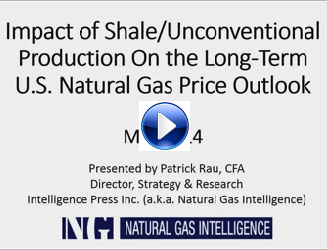Gas Export Authorization Could Bring on Haynesville Production; Export Pricing a Problem
It wouldn’t be a stretch for the United States to ramp up production to serve a 10 Bcf/d liquefied natural gas (LNG) export market by 2020, but whether the prospective exports would cause higher domestic natural gas prices could hinge on whether those exports are tied to Henry Hub gas or to or higher Brent crude equivalents, according to Patrick Rau, Natural Gas Intelligence (NGI) director of strategy and research.

Without exports, Rau sees a mismatch between the expected 2-3% annual production growth increase in the United States over the next six years and domestic consumption growth, which stays in the 1.5% to 2.5% per year range. U.S. gas shale plays, the Marcellus in particular, are only getting more efficient, and they are well on their way to flooding the domestic market in the long term.
Some of that excess Marcellus Shale gas flowing south to Gulf Coast LNG terminals through new and reversed pipelines already in the planning stages or under construction, could be augmented with a revival of the Haynesville Shale, which can be extremely prolific at the right price. In a 45-minute free webinar accessible on NGI‘s website under the “Research” tab, Rau explains how slightly higher prices would bring the Haynesville into play. He expects the real long-term breakeven natural gas price to range between $3.95/Mcf and $5.00/Mcf, with an average of $4.79/Mcf.
Those prices are based on today’s cost structure, but “technological advances should help push unit costs lower over time, so we believe U.S. natural gas prices will face negative pressure going forward, everything else being equal,” he said.
“Much of the gas to be exported could come from the currently uneconomic Haynesville Shale. Louisiana’s Haynesville has a lot of points in its favor. It is very close to a lot of prospective LNG export facilities; it’s dry gas so it doesn’t have to be processed; it’s near pipeline capacity; and it has the backing of the BG Group, one of the largest LNG traders, or players in the world,” Rau said in his report assessing North American unconventional gas supply and demand, now and prospectively.
It might take a $5.00 price to entice Haynesville producers. “Bringing on the Haynesville for exports could temporarily raise average prices, but that could be expected to level out as more supplies come on,” Rau said.
“However, if more of the LNG prices are pegged to oil, that would raise the overall average of LNG prices and could have an impact on natural gas prices in this country. That’s a big if. I know Asia is trying very hard to peg prices to the Henry Hub. That’s what buyers would like. If they don’t get it and more LNG is priced off crude then there definitely would be a long-term impact on the U.S. gas price in this country.”
© 2024 Natural Gas Intelligence. All rights reserved.
ISSN © 2577-9877 | ISSN © 1532-1266 | ISSN © 2158-8023 |
